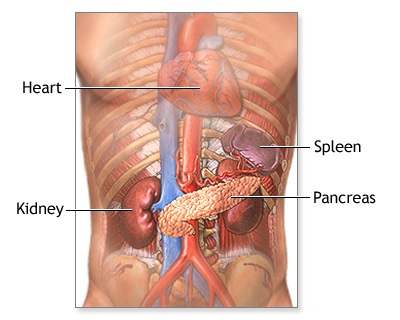
The pancreas is a large gland that lies alongside the stomach and the small bowel. It is about six inches (approximately 15 cm) long and is divided into the head, body and tail.
The pancreas carries out two important roles:
- It makes digestive juices, which consist of powerful enzymes. These are released into the small bowel after meals to break down and digest food.
- It makes hormones that control blood glucose levels.
The most important hormone that the pancreas produces is insulin. Insulin is released by the ‘beta cells’ in the islets of Langerhans in response to food. Its role is to lower glucose levels in the bloodstream and promote the storage of glucose in fat, muscle, liver and other body tissues.
‘Alpha cells’ in the islets of Langerhans produce another important hormone, glucagon. This has the opposite effect to insulin, by helping release energy into the bloodstream from where it is stored, thus raising blood sugar levels. Therefore, glucagon and insulin work in tandem to control the balance of glucose in the bloodstream.
Other hormones produced by the pancreas include pancreatic polypeptide and somatostatin. They are believed to play a part in regulating and fine-tuning the insulin and glucagon-producing cells.
Picture Credit : Google

